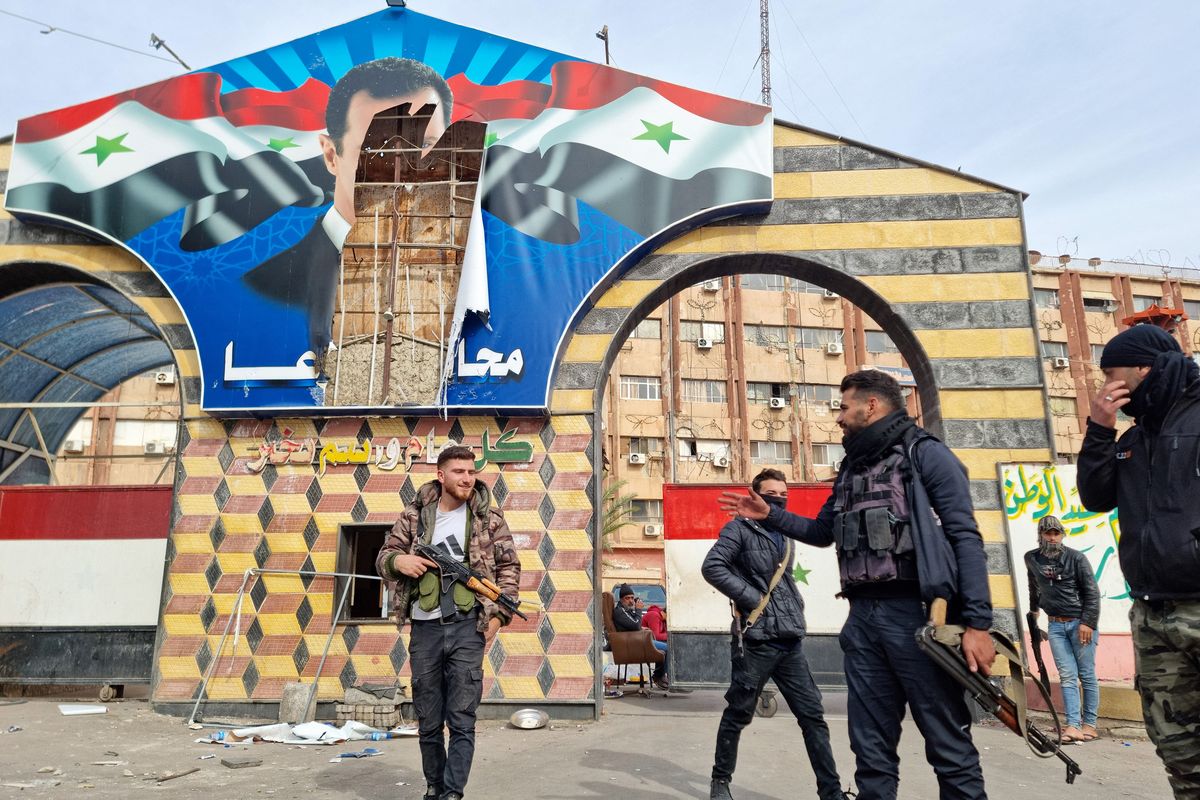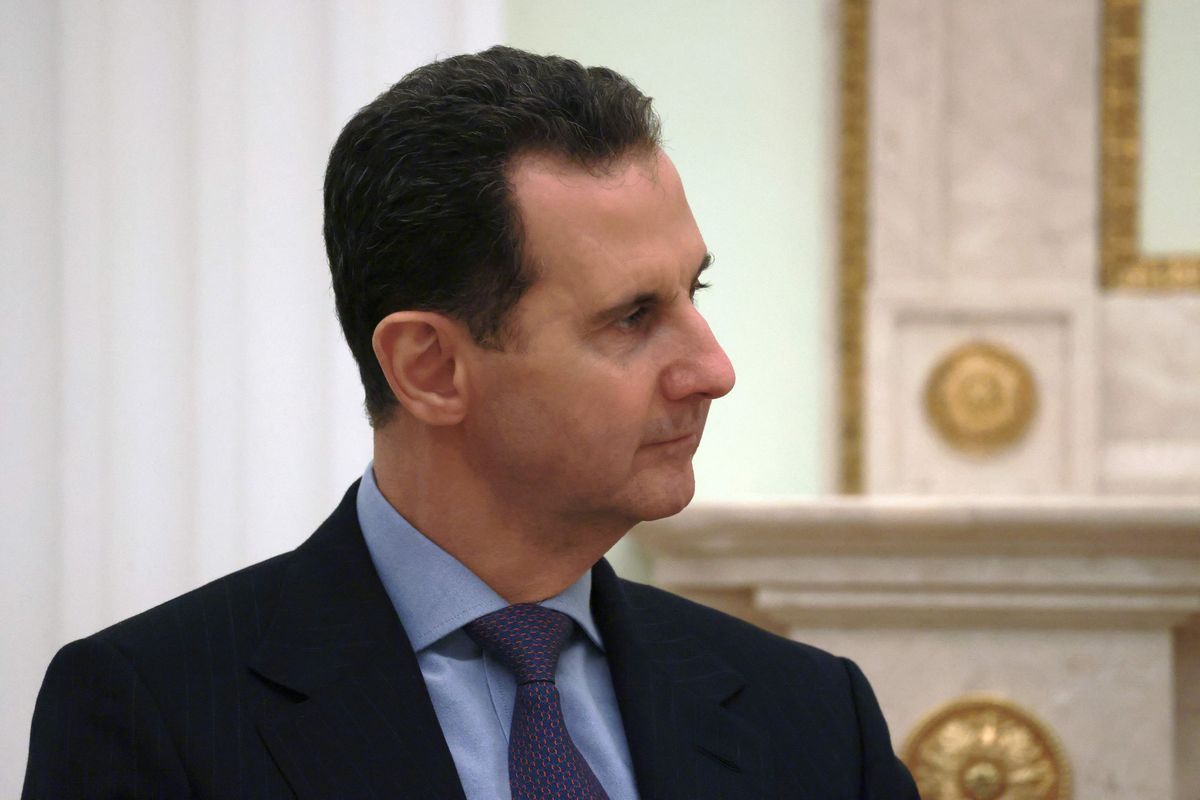Rebels enter Damascus, threatening Assad’s rule
Anti-government fighters stand in front of a defaced portrait of Syrian President Bashar Assad as they patrol a street Saturday in the Syrian southern city of Daraa. (Sam Hariri/AFP)
Rebel fighters stormed into Syria’s capital, Damascus, on Sunday, taking them to the brink of a stunning victory as Syrian forces and their leader, President Bashar Assad, appeared to be fleeing.
In just two weeks, a bitter stalemate that had held for years in Syria has been snapped.
The main rebel coalition announced on its Telegram channel on Sunday that it had taken Damascus, while two Iranian officials confirmed that the fighters had entered the capital and Syrian forces were withdrawing.
After Assad had kept rebel forces at bay for more than a decade with Iranian and Russian military support, a coalition of rebel groups that had been pinned into a small corner of the country’s northwest has swept through the country and its major cities. First the rebels seized Syria’s largest city, Aleppo, then days later blazed through Hama and the strategic city of Homs, en route to the capital.
Amid widespread reports of Syrian government troops fleeing their posts and peeling off uniforms, the sounds of gunfire erupted in Damascus before dawn Sunday, witnesses said.
The main rebel coalition announced on its Telegram channel Sunday that Assad had fallen, and that Damascus was “free from the tyrant.” The report could not immediately be confirmed.
Russia, Assad’s other important ally through nearly 14 years of civil war, has offered only limited aid.
British-based war monitor Syrian Observatory for Human Rights said government forces have pulled out of a number of suburbs of the capital, including Moadamia al-Sham and Daraya, and the nearby Mezzeh military airport. That could not be immediately confirmed.
The Observatory also reported that residents of another Damascus suburb, Jaramana, came out in an anti-government protest, chanting anti-Assad slogans and pulling down a statue of Hafez Assad, the current president’s father and predecessor.
Syrian state media reported that Bashar Assad was still in Damascus.
Assad’s control in southern and northeastern Syria, too, appeared to be crumbling, with a different coalition of rebel factions capturing much of Daraa province in the south, and U.S.-backed Kurdish-led forces moving into the city of Deir el-Zour in the northeast, according to the Observatory.
The group leading the main offensive said it was preparing to surround the capital, which rebels had attacked early on in the civil war but had not entered since.
“Our forces have begun implementing the final phase of encircling the capital Damascus,” a rebel commander, Lt. Col. Hassan Abdulghani, said Saturday afternoon in a statement posted on the rebels’ Telegram channel. He gave no further details and it was not immediately clear whether any operation on the ground near Damascus was underway.
“We have started sending more reinforcements from the north and south to the axes of the capital Damascus to support our ongoing operations there,” Abdulghani said hours later.
Russia and Iran lent robust military support to Assad over the past decade, proving crucial to his survival through Syria’s civil war.
But late Friday, Iran moved to start evacuating military commanders and other personnel from Syria, according to Iranian and regional officials.
There were also few signs that Russia, another major ally, was coming to the Syrian government’s aid, beyond some limited airstrikes. Russia intervened in Syria’s civil war in 2015 and helped keep Assad in power by bombarding rebel-held areas into submission. But the Russian military is stretched thin, with much of its air and ground force tied up in Ukraine.
Analysts said Russia sees little incentive to intervene more forcefully in Syria given the apparent ineffectiveness of Assad’s own forces.
“The Syrians need to be the ones defending Homs,” said Anton Mardasov, a Moscow-based military analyst focusing on the Middle East. “If they are running away, then no one will be fighting in their place.”
Earlier Saturday, opposition fighters in Homs faced some of the stiffest resistance they have encountered so far from government forces there, who are trying to block the rapidly moving rebel advance heading toward Damascus.
Syrian government forces were stationed on the outskirts of Homs and were shelling areas newly captured by the rebels, according to the Observatory. There were also clashes between rebels and government forces north of the city, the war monitor said.
But by early Sunday, the rebels and the Observatory said fighters had breached the city.
“Syria is witnessing a historic change,” rebels said in a statement released on their official Telegram channel. “And the people’s message has become clear: There is no place for injustice, no return to tyranny, and the end is closer than Bashar imagines.”
An array of groups has been taking territory from the government in other parts of the country as well. Government forces and their Russian allies withdrew from more than a dozen positions in the southwestern province of Quneitra near Israel and rebels took over the positions, according to the Observatory.
In eastern Syria, government forces in the city of Deir el-Zour have nearly entirely withdrawn from their positions, including from the airport and a military base, according to the Observatory. In their place, Kurdish-led forces backed by the United States have sent military reinforcements and released prisoners from a military prison there, the war monitoring group said.
With Syria’s allies pulling back, the weakness of the national military has come on full display.
Despite four years of a frozen conflict, analysts say the Assad government has done little to strengthen its military ranks, confident in an ultimate victory over the opposition. Instead, the military ranks remain filled with unwilling and poorly paid conscripts, young men forced into military service.
On Wednesday, Assad ordered salaries for his forces increased by 50%. But that was not expected to prevent more soldiers from fleeing the front lines.
U.S. officials, speaking on condition of anonymity, said Damascus could soon be under threat. A senior State Department official said Assad needed ground forces and that Iran would be hesitant to provide any.
The U.S. Embassy in Damascus on Friday urged U.S. citizens to leave Syria now.
“The security situation in Syria continues to be volatile and unpredictable with active clashes between armed groups throughout the country,” an Embassy statement said.
The main rebel offensive charging south toward the capital is led by the Islamist group Hayat Tahrir al-Sham. It has taken major cities and large parts of four provinces since launching a surprise offensive last week from its base in northwestern Syria.
In the southern province of Daraa – where the Syrian uprising against Assad’s authoritarian rule began in 2011 – a separate grouping of local rebel factions has taken control of more than 80% of the province after government forces withdrew from checkpoints and military headquarters, according to the Observatory.
And in the neighboring province of Sweida, a different array of local opposition groups attacked police and military checkpoints and took control of the main prison.
This article originally appeared in The New York Times.

